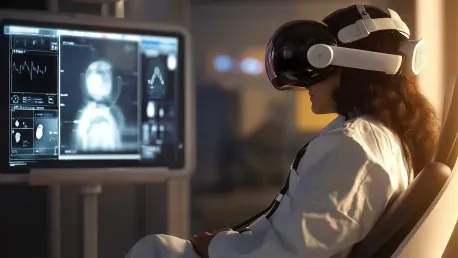Virtual reality (VR) is making waves in the field of mental health, offering new possibilities for treating conditions like anxiety and stress. The immersive nature of VR creates controlled environments that can aid therapeutic processes by tricking the brain into feeling present in these virtual worlds. This mode of therapy holds promise for providing more tailored and effective treatment options for a wide range of mental health conditions, which could revolutionize how professionals approach anxiety and stress disorders. Clinicians and researchers are eagerly exploring VR’s full potential, aiming to understand its limitations and benefits.
Understanding VR Therapy
VR therapy employs advanced technology to simulate lifelike environments that engage multiple senses. Using precise motion tracking and immersive visual and auditory stimuli, VR tricks the brain into feeling present in the virtual environment. This level of immersion can be especially beneficial in a therapeutic setting, as it allows for the controlled recreation of scenarios that might induce stress and anxiety. For instance, a person with social anxiety might be immersed in a virtual party or a public speaking scenario, allowing them to gradually confront their fears under the supervision of a skilled therapist.
The controlled nature of these virtual scenarios is particularly helpful for patients with anxiety and stress. Gradually facing triggers in a secure, measured environment helps individuals to manage their symptoms incrementally. VR therapy allows for precise calibration of scenarios, ensuring that the patient is not overwhelmed. The immersive experience creates a sense of presence that traditional therapy methods simply cannot replicate, which helps in managing real-life situations better.
The Appeal and Functionality of VR Therapy
One of the most effective uses of VR in therapy is exposure therapy. This method involves the gradual, controlled exposure to anxiety-inducing stimuli, under the guidance of a professional. This systematic desensitization helps individuals manage their fears more effectively. For example, combat veterans suffering from PTSD can use VR to relive combat situations in a controlled and safe environment. Therapists can pause, rewind, or alter the scenario to better suit the therapy’s pace, making it less daunting for the patient and more adaptable to their needs.
VR exposure therapy’s adjustable and controlled nature is one of its most appealing aspects. Unlike traditional in-vivo exposure, VR provides a customizable setting where variables can be controlled down to the smallest details. Patients can be introduced to stressors gradually, such as increasing the crowd in a virtual social setting or adding more interactive elements. This kind of calibration ensures that exposure is manageable and therapeutic progress is made without causing undue stress or regression.
Cognitive Behavioral Therapy (CBT) and Other Techniques
Beyond exposure therapy, VR is also employed to enhance Cognitive Behavioral Therapy (CBT). CBT focuses on identifying and altering negative thought patterns, and the immersive nature of VR can make this process more engaging and effective. Companies like Oxford VR are at the forefront of developing VR simulations that guide patients through CBT exercises within virtual scenarios. These immersive sessions allow patients to practice CBT techniques in real-time, facing and overcoming their fears in a safe setting. For example, a VR program for someone with a fear of heights might involve gradually ascending a tall building, aided by a virtual coach.
Mindfulness and guided meditation are additional therapeutic techniques benefiting from VR. Applications like Tripp VR generate calming, 360-degree nature environments and combine these with biofeedback tools to help users achieve a state of calmness. This approach provides an innovative way to practice meditation and mindfulness, especially for those who struggle to relax in conventional settings. Early studies suggest that VR meditation can positively impact anxiety and stress levels. However, more extensive research is called for to confirm these preliminary findings and fully understand its long-term benefits.
Data Privacy and Ethical Considerations
The therapeutic benefits of VR come with significant privacy concerns. VR headsets and applications collect extensive data, from movement patterns to biometric responses and emotional states. This depth of data collection raises serious ethical questions about its security and use. Unlike traditional therapy sessions, which remain confidential within the confines of an office, VR therapy involves hardware and software that can record sessions. This increases the risk of the sensitive data being leaked, mishandled, or misused. The potential for data breaches is a genuine concern.
Moreover, the unregulated nature of VR therapy data exacerbates these privacy issues. Many VR platforms have user agreements that allow the sharing or even selling of user data, a troubling notion given the highly sensitive nature of mental health information. The implications of such misuse could be severe, leading to situations where therapy sessions are used to target advertising or for other ethically questionable purposes. Stronger regulations and more stringent oversight are clearly needed to safeguard the privacy of patients engaging in VR therapy.
Risks and Challenges
Data privacy is not the sole concern when it comes to VR therapy. The risk of data being mishandled or manipulated poses an ethical challenge that cannot be ignored. Issues of informed consent become paramount, especially when users may not fully understand the extent of data being collected or how it is used. The lack of standardized regulations creates a precarious environment where patient data is vulnerable to breaches and misuse. This becomes even more concerning when considering mental health data, which is deemed highly sensitive.
In addition to privacy concerns, the ownership and security of data generated during VR therapy pose another critical issue. Clinical and academic researchers typically operate under stringent regulations like HIPAA, which ensure data protection. However, consumer-oriented VR applications and platforms often do not provide the same level of security. For tech giants and startups entering the VR space, without robust oversight, this data could be exploited. Patients, therefore, need to remain vigilant about the platforms they use and the policies governing data usage.
Ownership and Security
To ensure patient data is kept secure, users and practitioners alike need to prioritize data protection. Choosing VR therapy platforms that comply with established privacy regulations such as HIPAA and GDPR is crucial. Patients are advised to use strong, unique passwords and enable two-factor authentication to add layers of security. Additionally, employing a VPN can encrypt data transmissions, offering another layer of protection during VR therapy sessions.
Security measures are just the beginning. Ensuring the ethical use of VR therapy requires transparent policies and open communication between providers and patients. Both parties should be aware of what data is collected, how it is stored, and who has access to it. Continued advocacy for more stringent data protection laws and ethical guidelines in VR therapy can help protect patient privacy and maintain trust in these innovative treatment methods.
The Future of VR Therapy
Virtual reality (VR) is making significant progress in the realm of mental health, opening up new avenues for treating conditions such as anxiety and stress. The immersive aspect of VR allows the creation of controlled environments that can facilitate therapeutic processes by tricking the brain into thinking it is truly present in these virtual scenarios. This type of therapy shows great potential in offering more personalized and effective treatment options for a diverse array of mental health issues, which could potentially transform the approach that mental health professionals take towards managing anxiety and stress disorders.
As clinicians and researchers delve deeper into the capabilities of VR, they are particularly focused on understanding both its benefits and its limitations. The goal is to integrate VR more seamlessly into existing therapeutic practices, which could ultimately lead to more effective interventions and improved patient outcomes. Additionally, VR could enable therapists to offer exposure therapy in a more controlled and safe manner, providing a valuable tool for those dealing with phobias and PTSD. Overall, the exploration of VR’s full potential in mental health care is an exciting and evolving field, promising significant advancements in how we treat and understand various mental health conditions.









